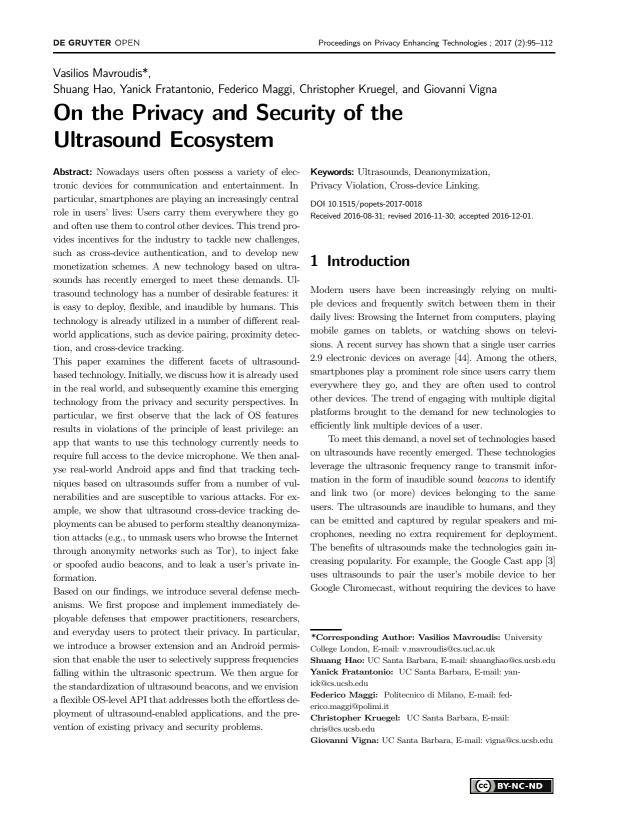On the Privacy and Security of the Ultrasound Ecosystem
Authors: Vasilios Mavroudis (University College London), Shuang Hao (UC Santa Barbara), Yanick Fratantonio (UC Santa Barbara), Federico Maggi (Politecnico di Milano), Christopher Kruegel (UC Santa Barbara), Giovanni Vigna (UC Santa Barbara)
Volume: 2017
Issue: 2
Pages: 95–112
DOI: https://doi.org/10.1515/popets-2017-0018
Abstract: Nowadays users often possess a variety of electronic devices for communication and entertainment. In particular, smartphones are playing an increasingly central role in users’ lives: Users carry them everywhere they go and often use them to control other devices. This trend provides incentives for the industry to tackle new challenges, such as cross-device authentication, and to develop new monetization schemes. A new technology based on ultrasounds has recently emerged to meet these demands. Ultrasound technology has a number of desirable features: it is easy to deploy, flexible, and inaudible by humans. This technology is already utilized in a number of different realworld applications, such as device pairing, proximity detection, and cross-device tracking. This paper examines the different facets of ultrasoundbased technology. Initially, we discuss how it is already used in the real world, and subsequently examine this emerging technology from the privacy and security perspectives. In particular, we first observe that the lack of OS features results in violations of the principle of least privilege: an app that wants to use this technology currently needs to require full access to the device microphone. We then analyse real-world Android apps and find that tracking techniques based on ultrasounds suffer from a number of vulnerabilities and are susceptible to various attacks. For example, we show that ultrasound cross-device tracking deployments can be abused to perform stealthy deanonymization attacks (e.g., to unmask users who browse the Internet through anonymity networks such as Tor), to inject fake or spoofed audio beacons, and to leak a user’s private information. Based on our findings, we introduce several defense mechanisms. We first propose and implement immediately deployable defenses that empower practitioners, researchers, and everyday users to protect their privacy. In particular, we introduce a browser extension and an Android permission that enable the user to selectively suppress frequencies falling within the ultrasonic spectrum. We then argue for the standardization of ultrasound beacons, and we envision a flexible OS-level API that addresses both the effortless deployment of ultrasound-enabled applications, and the prevention of existing privacy and security problems.
Keywords: Ultrasounds, Deanonymization, Privacy Violation, Cross-device Linking.
Copyright in PoPETs articles are held by their authors. This article is published under a Creative Commons Attribution-NonCommercial-NoDerivs 3.0 license.

